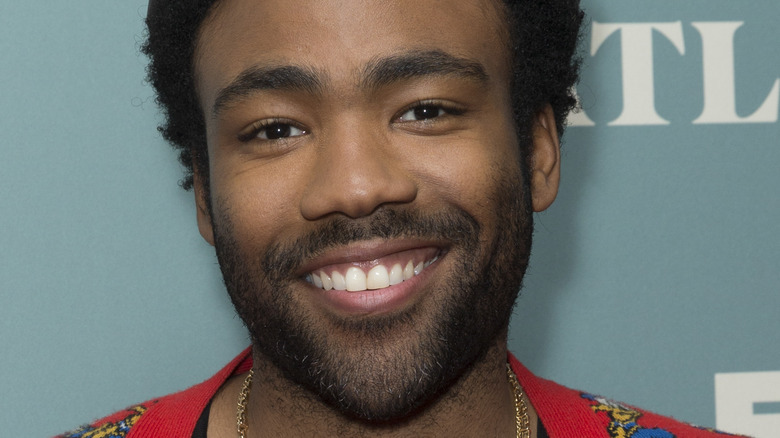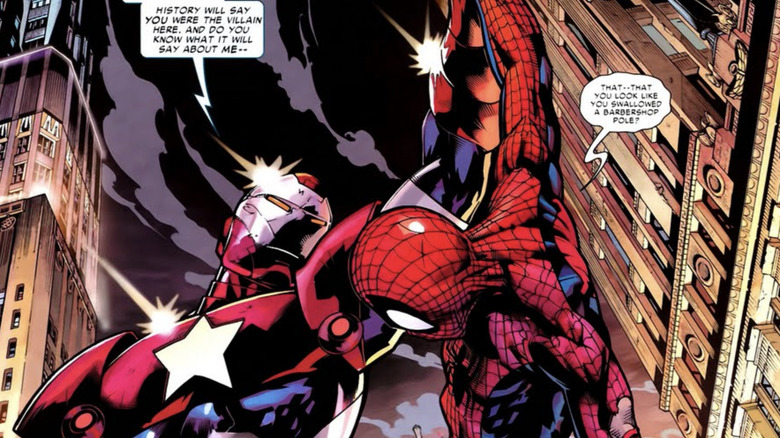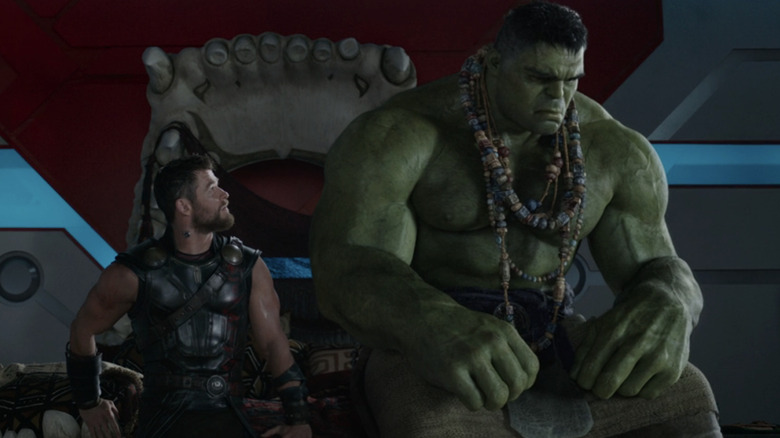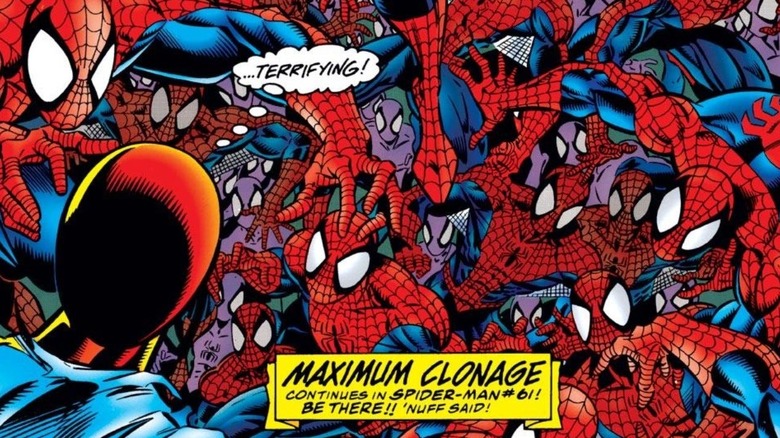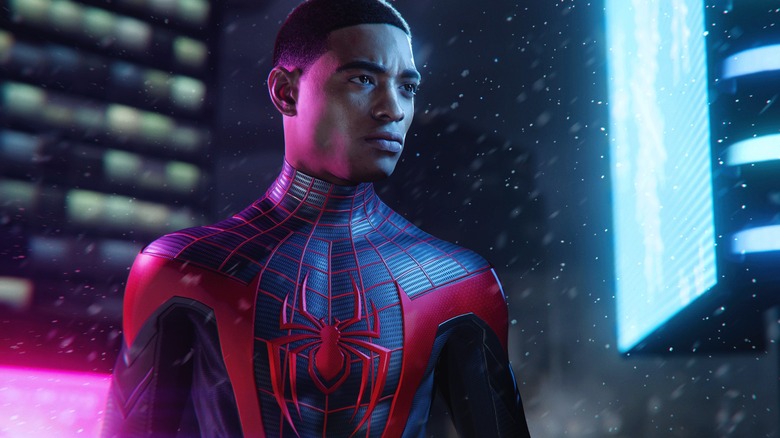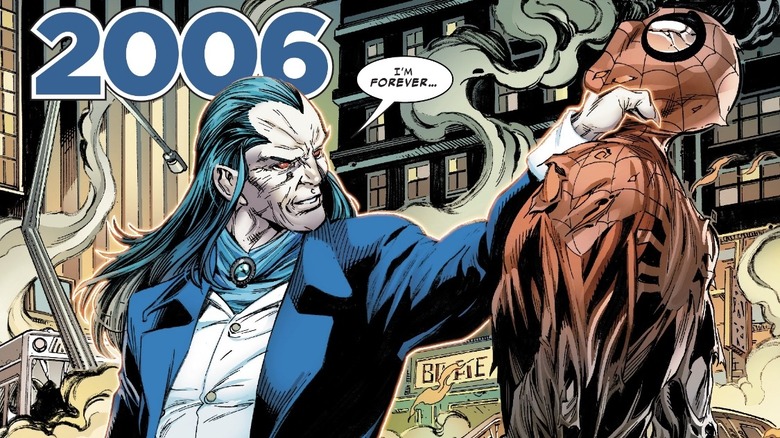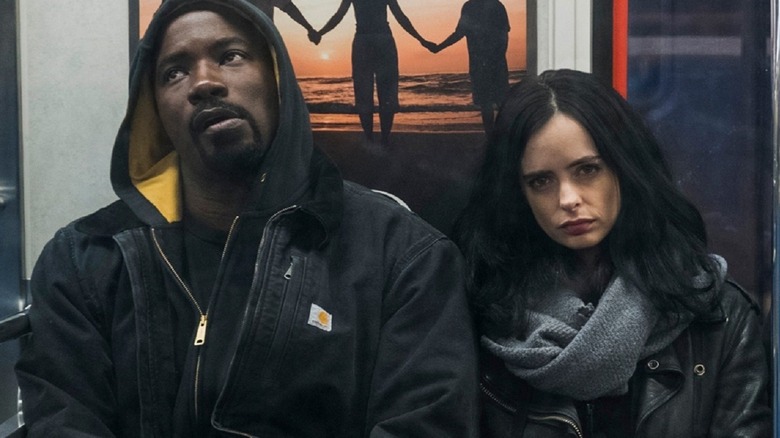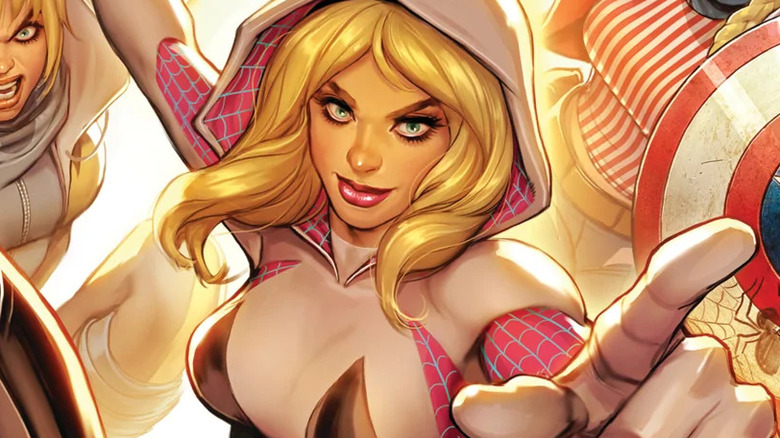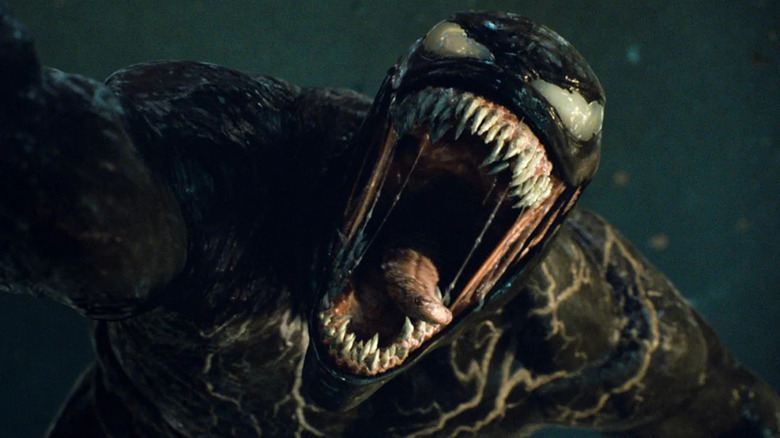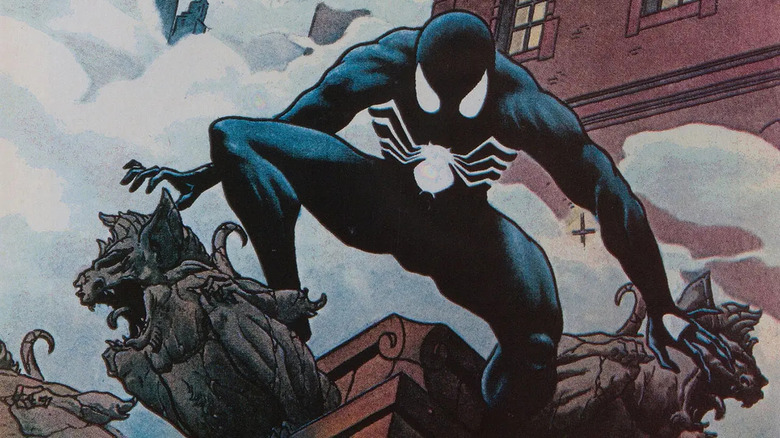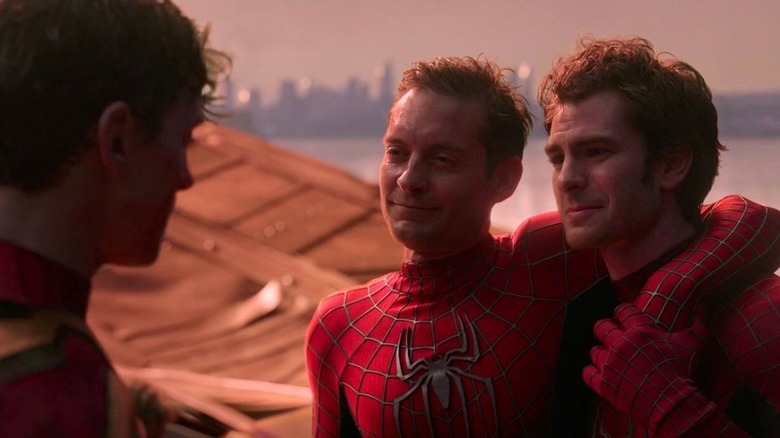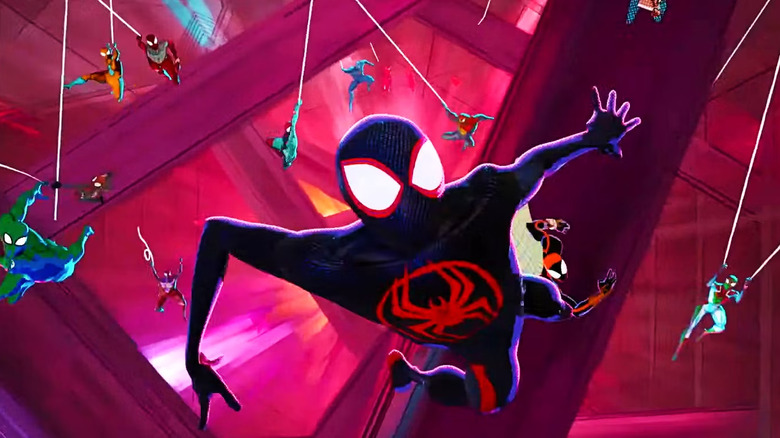11 Ways Sony Can Expand The Spider-Verse After Hypno-Hustler
It has been a rocky couple of decades for Sony's Spider-Man franchise. After the unqualified success of Sam Raimi's "Spider-Man" and "Spider-Man 2" in 2002 and 2004, the character, his accompanying universe, and even its parent company have been on a wild, web-slinging ride.
Three live-action Spider-Men and countless animated Spider-people later, Sony's Spider-Man Universe is at an existential crossroads, which has led Sony to consider some truly unexpected paths forward. Case in point: The announcement that award-winning polymath Donald Glover will star in a movie as the Hypno-Hustler, one of the most obscure Spider-Man villains out there.
The Hypno-Hustler film could certainly be a hit, especially with Glover in the dual role of star and producer, but by any metric, basing a movie around a C-list villain with no name recognition is a risk. The closest Marvel concepts to see release so far are 2005's "Elektra" and 2022's "Morbius," both of which became notorious flops, critically and commercially. That checkered past is exactly why the future of Sony's Spider-Man Universe desperately needs to move forward in the right direction, whether Hypno-Hustler works or not.
We here at Looper love our Spider-people, be they Peter Parker, Miles Morales, Gwen Stacy, or any of the other hundreds of beings to don the tights and webs. There are a few ways that Sony can expand the Spider-Verse after Hypno-Hustler.
1. Dark Reign and the public menace
At the tail end of "Spider-Man: Far From Home," Marvel and Sony introduced the concept of a Spider-Man who was seen as an outlaw and a criminal that was wanted by the police. The gimmick was short-lived, however, as it proved to merely be a set-up for the events of "Spider-Man: No Way Home."
For longtime fans of Spidey's comics, this tease and walk-back is a bit of a letdown, as one of the character's most enduring traits is his dubious relationship with the law and his constant public branding as a vigilante and public menace.
His constant war with J. Jonah Jameson over his portrayal in the media is a highlight of the character's ongoing "Parker Luck," and Sony has at least one surefire way to visit that on the big screen: By adapting the storyline "Dark Reign."
"Dark Reign" was not a Spidey-specific story, but it might as well have been: It followed the ascent of longtime Spider-Man villain Norman Osborn, to his new position as head of SHIELD. Once in power, he begins cracking down on costumed vigilantes, and as you would expect from Osborn: Spider-Man is at the top of that list.
There is a lot of fun to be had in the storyline, not only by bringing a core component of Spider-Man to life and challenging Spider-Man in a new way on screen but also for the opportunity to cast Willem Dafoe as the most Osborn-iest Osborn yet.
2. The MCU's team-up formula
It's no easy task keeping a connected cinematic universe afloat. A number of hurdles make it infeasible for every entry to be as massive a team-up as "Avengers: Endgame." And yet the smaller, more self-contained films still need to feel as if they fit within the larger setting. One trick the MCU has employed to manage this Celestial-sized balancing act is turning the solo projects into buddy team-ups.
Marvel has wisely chosen to use every supposed solo film as an opportunity to either introduce a new superhero or use an existing superhero as an ally and foil to the starring character. Examples include Thor and Hulk's team-up in "Thor: Ragnarok," Spider-Man and Iron Man's team-up in "Spider-Man: Homecoming," and many more. The setting of "Sony Spider-Man Universe" is so rich with potential characters and yet still so disjointed, so the MCU team-up formula might be just what the Doctor Octopus ordered.
This approach is adaptable, too: The studio could pair Tom Holland with an existing character to finally bring a sense of unity to the setting, use a team-up between Holland and a new Spider-person as a way of phasing Holland out, or go with a team-up of two new characters without combining too many spider eggs into one basket.
3. The Clone Saga
Surprisingly, despite the wealth of Spider-Man movies in the past two decades, and even with multiple incarnations of the character among them, the most iconic Spider-Man comics have yet to be adapted for the big screen. There is a massive abundance of popular stories for Sony to harvest and adapt for future projects, and one of the all-time best is "The Clone Saga."
The arc ran throughout the mid-'90s, and true to its name, it introduced a number of clones of Parker, sewing some of the first seeds for what would eventually become the Spider-Verse. Perhaps more importantly for a production studio like Sony, the storyline's premise comes with a baked-in method to establish new, original Spider-Men in a plausible way without needing much, if any, commitment from Holland.
The '90s storyline was controversial (to put it diplomatically) for its decision to replace Parker as the main Spider-Man with Ben Reilly, an identical clone. Though Reilly proved unpopular as Spider-Man, he did find a second life as the Scarlet Spider (as did another Parker clone, Kaine), and both have joined Parker in his multiple "Spider-Verse" adventures.
Importantly, the inherent value in adapting "The Clone Saga" is independent of Reilly and Kaine and every other specific Spider-person: It comes from a feasible, canonical way for Holland to pass the torch or simply to set a few more torches alight beside his.
4. Live-action Miles Morales
From a business standpoint, this is a no-brainer: A live-action Miles Morales movie would be a hit. The character is beloved enough to even help lead "Spider-Man: Into the Spider-Verse" to critical and commercial success, a major surprise to many, given the project's seemingly risky style and cast.
Morales's live-action transition to the big screen has been in demand for so long that, way back in the 2010 Season 2 premiere of "Community," Glover's character Troy sports Spider-Man pajamas, a nod to the already long-standing campaign to cast the actor as Morales.
Since Glover has aged out of the role and is now set to play Hypno-Hustler, the actor is firmly out of the race to play Morales. Morales himself, however, displays the agelessness typical of comic-book characters and so is as ready as ever to make the superhuman leap to leading a live-action movie.
Numerous young actors have been rumored to be in consideration for the role already, including Jaden Smith and Dallas Dupree Young, but regardless of which actor wins out, the film is virtually guaranteed to be a massive box-office draw, and therefore Morales a franchise-making role.
5. Morlun and mysticism
Like the idea of Spider-Man as an unwanted vigilante and public menace, the concept of the hero as a mystical figure is one that neither Sony nor the MCU has explored yet, although they certainly should consider it. For the majority of his publication history, the wall-crawler has only occasionally dipped his toes into the mystical world, most often during the occasional team-up with Doctor Strange, but that all changed when writer J. Michael Straczynski took over "Amazing Spider-Man" in the early 2000s.
Like "The Clone Saga," Straczynski's run was exceptionally controversial due to the sweeping changes it made to the Spider-quo, but it incontrovertibly accomplished two things: Opening up a new suite of Spider stories to tell and setting all the subsequent Spider-Verse stories in motion.
The run revealed that Parker's powers made him a type of totemistic force, an avatar for a multiversal network known as the Web of Life and Destiny. As contrived as the name may be, it does create an innate bond between the Parker of Earth-616 and all other Spider-People, hence its inclusion in the original "Spider-Verse."
Alongside a general connectedness, the mystical side of Spider-Man also comes with its own outstanding villain: Morlun. The vampiric Morlun gains power by feeding on totems, not just spiders but any kind: Hence his attempt to consume the Panther totem from Black Panther: And so prowls the strands of the great Web, seeking totems upon which to feed.
6. Rent the Defenders
It was pure joy for fans when Charlie Cox's Daredevil returned to the MCU in "Spider-Man: No Way Home," and it was even more joyous when Marvel announced the character would receive a new series in "Daredevil: Born Again." Sadly, the rest of Netflix's lineup of Defenders isn't quite so lucky, as no other Netflix series has been given the same green light to make the jump to the new MCU. The good news is that both canonically and financially, this makes the other Defenders a relatively easy get for Sony and their Spider-Man Universe.
Additionally, Spider-Man and the Defenders have a long, consistent history together, as they are all considered street-level heroes by Marvel, making the opportunity even sweeter. On top of that, during the first volume of "New Avengers," the new team lineup eventually came to include Spider-Man and all three of the other Netflix Defenders: Iron Fist, Luke Cage, and Jessica Jones.
The characters all have long-standing relationships, which would grant both Sony and Marvel a considerable amount of built-in interest from comic fans. But more than that, allowing Spider-Man (again, whether it's Holland or not) to star alongside the others would mark a dramatic step forward in uniting the various cinematic Marvel universes (Sony's Spider-Man Universe, the Netflix quasi-MCU, and the MCU proper) into one coherent setting for movie-goers.
7. Gwen takes the lead
Now that Shuri has taken up the mantle of the Black Panther and Riri Williams has created her own Ironheart suit in "Black Panther: Wakanda Forever," almost every major MCU hero now has a female counterpart or successor. All six original Avengers and other major figures like Black Panther and Doctor Strange all have female equivalents, leaving only one big player left in the patriarchal dust: Spider-Man.
However, perhaps no other character has more female alternates than Spider-Man in the comics, and at least one of them, the heroine formally named Spider-Gwen and now Ghost-Spider, is due her day in the MCU sun. Gwen Stacy, the woman who dons the mask and hood as Ghost-Spider, is a tremendously important figure in the Spider-Man canon, and that's largely for one controversial reason: She's potentially one of the earliest and most flagrant examples of "fridging" in comics.
Fridging refers to the trope of killing off a female love interest simply to further the male hero's story, thus dehumanizing her in the process and turning her into a mere plot point. Such was the case with the original Gwen Stacy, and now that she has resurfaced in Marvel comics as a powerful, popular hero in her own right, Stacy is in the perfect position to become Sony's next big Spider-person.
8. Finally: Spider-Man vs. Venom
Sony knows what fans want to see from their Spider-Man Universe, and so do its stars. When Venom portrayer Tom Hardy was asked about the possibility of the two heroes/antiheroes meeting on film, he answered that he'd be overjoyed to be part of such a project. Holland also commented (as furtively as can be) that his cameo at the end of "Venom: Let There be Carnage" was "really exciting" and side-stepped the question as best he could while still making it clear that the union is very much possible and very much tempting.
There aren't many comic book showdowns more iconic and more popular with fans than Spider-Man versus Venom, and unlike so many Marvel properties, Sony has access (or at least partial access) to both, making the project an undeniable smash hit.
For those who don't know, the Venom character comes from Spider-Man comics originally, the living being revealed to be behind Spider-Man's black suit. Even when freed from Parker, the symbiote chose to keep some of Spider-Man's appearance and style, opting for a spider insignia on its chest and webs as its preferred form of transportation. Venom is so connected with Spider-Man that if the two characters never met, it would forever be an inky, black stain on Sony's record.
9. The symbiote suit
We're sure that it's technically possible to pit Venom and Spider-Man against each other in a movie and not place Parker in the symbiote suit, but we can't imagine it happening any time soon, and that is more than fine. Spider-Man fans have a few desires that transcend space, time, and the boundaries of different media: At or near the top is to see Spider-Man don the symbiote suit and finally stop holding back on his enemies and looking super cool while doing it.
There are other reasons to consider the iconic black suit aside from the visual appeal and the outfit's history of iconic moments, too. For one, it's neither Parker-specific nor Holland-specific (though "Spider-Man: No Way Home" concept artist Thomas du Crest did share his take on Holland in the suit, and it looks stellar).
Morales has also sported his own symbiote, as has Stacy, and whenever fans are made to suffer the loss of Holland as franchise lead, the pain could be greatly eased if the next film featured an MCU-canonical meeting between Morales/Stacy and Hardy's Venom. Taking that a step further, the suit as a prop and as its own character is also independent of Hardy's involvement, as well: With Morales or Stacy as the new host, Sony would only need to supply the suit's alien voice, if that.
10. Tobey Maguire and Andrew Garfield
It's hard to imagine a more surefire box office success for Sony's Spider-Man Universe than bringing back former Spider-Men Tobey Maguire and Andrew Garfield. Especially if it means reuniting the Holy Spider Trinity of Maguire, Garfield, and Holland established in "Spider-Man: No Way Home." The return of these two actors would guarantee an abundance of butts in seats.
With the MCU multiverse firmly established and explained with at least a modicum of clarity, Sony is free to re-introduce Maguire and/or Garfield in almost any way they choose. Of course, if the combined nostalgia and star power of the two actors were placed into one team-up film, the end result would be a massive draw. But the two actors by themselves, as well as their two versions of Parker, are still on many fans' wishlists when it comes to future Sony projects.
Fans have long yearned for a third movie featuring Garfield's Parker, with some claiming that his two films didn't do the character justice. For their part, both Maguire and Garfield have expressed in multiple interviews the joy they felt in returning as their respective Parkers in "No Way Home", as well as their willingness to return once more, should the right opportunity come along.
11. The actual Spider-Verse
Sony's handling of Spider-Man and his associated IP is impossible to condense into one take, but that may end up being its greatest strength and its best path forward. On the one hand, the studio has bungled films like "Morbius" and canceled a slew of Spider-Man-related films, such as "Sinister Six" and "Silver & Black" (which would have starred the Black Cat and Silver Sable).
On the other hand, Sony has released what many consider the best-animated superhero film of all time, "Spider-Man: Into the Spider-Verse": The film has received exceptional reviews by fans and critics alike, impressive box office profit, and an Academy Award nomination for Best Animated Feature.
Therein lies Sony's best option to consolidate its disparate films and characters, as well as set a standard for film quality going forward: Simply blend live-action and animated properties into one. By now, Marvel audiences are no strangers to inter-dimensional antics, and in fact, the very premise of "Into the Spider-Verse" and "Across the Spider-Verse" demand them.
As fun as it may be for the animated Morales to meet a Spider-Man 2099 voiced by Oscar Isaac or a Spider-Woman voiced by Issa-Rae, imagine the box-office sensation that would arise by including Holland, Hardy, or even Garfield and Maguire in the flesh.
